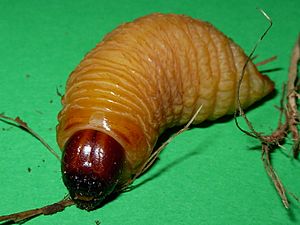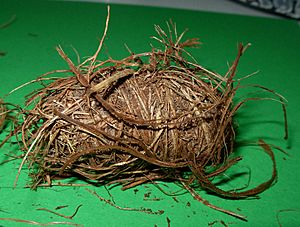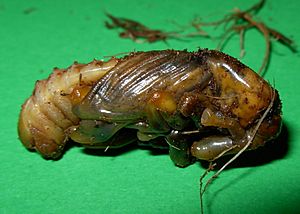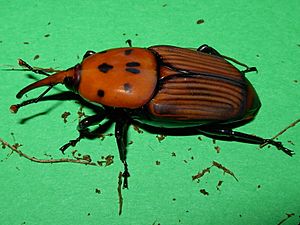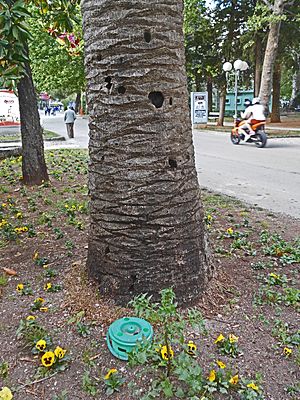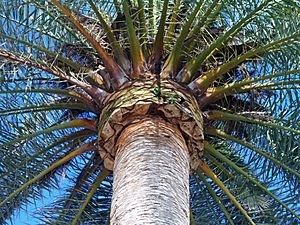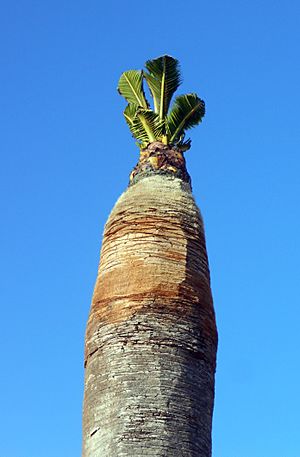Rhynchophorus ferrugineus facts for kids
Quick facts for kids Rhynchophorus ferrugineus |
|
|---|---|
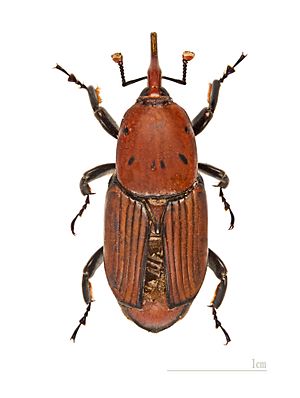 |
|
| Scientific classification | |
| Genus: |
Rhynchophorus
|
| Species: |
ferrugineus
|
| Synonyms | |
|
|
The red palm weevil (scientific name: Rhynchophorus ferrugineus) is a type of snout beetle. It's also called the Asian palm weevil or sago palm weevil. These adult beetles are quite big, usually between 2 and 4 centimeters (about 1 to 1.5 inches) long. They are often a rusty red color. However, they can come in many different colors.
The young weevils, called larvae, dig long tunnels inside the trunks of palm trees. These tunnels can be up to 1 meter (about 3 feet) long! This digging weakens the palm tree and can eventually kill it. Because of this, the red palm weevil is a big problem for palm farms. It attacks important trees like the coconut palm, date palm, and oil palm.
This weevil first came from tropical Asia. Over time, it has spread to Africa and Europe. It reached the Mediterranean area in the 1980s. It was first seen in Spain in 1994 and in France in 2006. It has also been found in many other countries, including Italy, Croatia, Portugal, Morocco, and Tunisia. In 2009, it was reported in the Americas on Curaçao and Aruba. There was a report in the United States in 2010, but it turned out to be a different, but similar, type of weevil.
Did you know that the larvae of the red palm weevil are eaten as a special food in some parts of Southeast Asia? But in some places, growing these larvae is not allowed. This is to help protect palm crops from being destroyed.
Contents
Where the Red Palm Weevil Lives
The red palm weevil originally lived in countries like Bangladesh, Cambodia, China, India, Japan, Laos, Pakistan, Philippines, Sri Lanka, Taiwan, and Vietnam. Now, it has spread to many other places around the world.
Countries Where It's Found
The red palm weevil has been found and confirmed in many countries. These include Albania, Algeria, Aruba, Bahrain, Bosnia and Herzegovina, Croatia, Curaçao, Cyprus, Egypt, France (including Corsica), Greece, Israel, Italy (including Sicily and Sardinia), Jordan, Kuwait, Libya, Malta, Monaco, Montenegro, Morocco, Oman, Palestine, Portugal (including Madeira), Qatar, Saudi Arabia, Slovenia, Spain (including the Balearic and Canary islands), Syria, Tunisia, Turkey, United Arab Emirates, and Yemen.
Some reports from Australia, Papua New Guinea, Samoa, the Solomon Islands, and Vanuatu might actually be about a different, but related, weevil species called Rhynchophorus bilineatus.
Palm Trees It Attacks
The red palm weevil is known to attack 19 different types of palm trees. It is considered the worst pest for palms worldwide. Even though it was first found on coconut trees in Southeast Asia, it has caused a lot of damage to date palms in the Middle East and then spread to Africa and Europe. This spread happened because infected palm plants were moved from one place to another.
In the Mediterranean area, the red palm weevil also causes serious harm to Phoenix canariensis trees. Today, this pest is found in about 15% of countries that grow coconuts and nearly 50% of countries that grow date palms.
Some of the palm trees that the red palm weevil attacks include:
- Areca catechu
- Arenga pinnata
- Borassus flabellifer
- Butia capitata
- Caryota urens
- Chamaerops humilis
- Cocos nucifera (coconut palm)
- Elaeis guineensis
- Jubaea chilensis
- Metroxylon sagu
- Phoenix canariensis
- P. dactylifera (date palm)
- Roystonea regia
- Sabal palmetto
- Trachycarpus fortunei
- Washingtonia filifera
- W. robusta
Scientists have also grown these weevils in labs using Agave americana and Saccharum officinarum as food. However, they haven't seen the weevils attack these plants in nature. Some palm species, like Washingtonia filifera and Chamaerops humilis, might be a bit more resistant to the weevil, even though they can still be attacked.
Life Cycle of the Red Palm Weevil
The red palm weevil usually attacks palm trees that are younger than twenty years old. While the adult weevil does some damage by eating, it's the larvae that cause the most harm. They burrow deep into the center of the palm tree, which can kill the tree.
The female adult weevil lays about 200 eggs. She places them on new growth at the top of the palm, at the bottom of young leaves, or in any open cuts on the tree.
Eggs and Larvae
The eggs hatch into white, legless larvae. These larvae eat the soft parts and new buds inside the tree. They tunnel through the tree's inner tissue for about a month. The larvae can grow to be about 6 to 7 centimeters (about 2.5 inches) long.
When it's time to change into an adult, the larva leaves the tree. It then builds a cocoon from dry palm fibers. This cocoon is usually found in leaf litter at the bottom of the tree. Inside the cocoon, the larva changes into a pupa. The entire life cycle, from egg to adult, takes about 3 to 4 months.
Adult Weevils
Adult red palm weevils are very good at flying and can travel long distances. They prefer to attack palm trees that are already weak or have been damaged. However, they can also attack healthy palm trees.
Natural Enemies of the Red Palm Weevil
The red palm weevil has some natural enemies. For example, a type of earwig called Chelisoches morio eats them. They can also get sick from certain viruses and fungi, like Metarhizium pingshaense. There are also tiny worms, called nematodes (like Heterorhabditis indicus), and wasps (like Scolia erratica) that can act as parasites, living on or in the weevil.
How Red Palm Weevils Behave
Scientists have studied how red palm weevils act in nature. They found that the weevils develop differently depending on what they eat. They grow fastest when eating palm crown (the top part of the palm tree). They also lay the most eggs when eating palm crown. This shows how much they prefer palm trees as food.
Studies also show that these insects are attracted to certain smells. These smells help scientists create traps to catch the weevils.
Signs of a Red Palm Weevil Attack
When a palm tree is attacked by the red palm weevil, its leaves might turn yellow and start to wilt. This can eventually lead to the tree dying. The top leaves usually wilt first, and then the lower leaves follow. This happens because the weevils damage the tree's internal systems that carry water and nutrients.
Often, you won't see these signs, like wilting leaves, until the palm has been infected for a long time. By the time you notice these outer signs, the damage is usually severe enough to kill the tree. The weevils might have been inside the tree for six months or even longer.
If many weevils are present, you might even hear the larvae chewing and burrowing inside the tree. You can hear this by putting your ear to the trunk. Newer ways to detect them early include using special listening devices or even dogs trained to sniff out the weevils or the smell of decaying palm.
-
Canary Island date palm, Phoenix canariensis, showing early signs of infection
-
A date palm that was killed by the pest in Kfar Saba, Israel
Controlling the Red Palm Weevil
One main way to control these weevils is by using special bug-killing chemicals called insecticides. These are often poured into a funnel placed on the tree trunk.
People also use traps with special smells (pheromones) to catch the weevils. Other methods include keeping palm farms very clean and setting up many traps with both pheromones and plant smells. New technologies are being developed to attract the weevils to a spot and then kill them.
Another way to fight them is to spray the base of palm leaves with certain fungi, like Metarhizium anisopliae or Beauveria bassiana, which can infect and kill the weevils. One company even claims to have a special microwave collar that can sterilize individual trees. For finding weevils early, scientists can put sensitive microphones into trees to listen for sounds made by the weevils. These sounds are then analyzed by computers to see if weevils are present.
Preventing Attacks
Since the weevil likes to lay its eggs in softer parts of the tree, avoiding damage to palm plants can help prevent attacks. Covering wounds on the tree with tar after trimming dead or old leaves can also make it less likely for weevils to infest. It's also important not to move palm materials like husks or dead leaves from areas where weevils are present to areas that are free of them.
Red Palm Weevil Larvae as Food
The larvae of the red palm weevil are considered a special food in Vietnam. In Vietnam, the larvae are often eaten alive with fish sauce. They can also be toasted or steamed. People eat them with sticky rice and salad, or cook them in porridge. In Vietnamese, these larvae are called đuông dừa, which means "coconut beetle-larva." Other countries like Malaysia and New Guinea also eat "sago worms," but these are usually different, but related, types of Rhynchophorus weevils.
Additional Resources
- USDA information page
See also
 In Spanish: Picudo rojo para niños
In Spanish: Picudo rojo para niños


